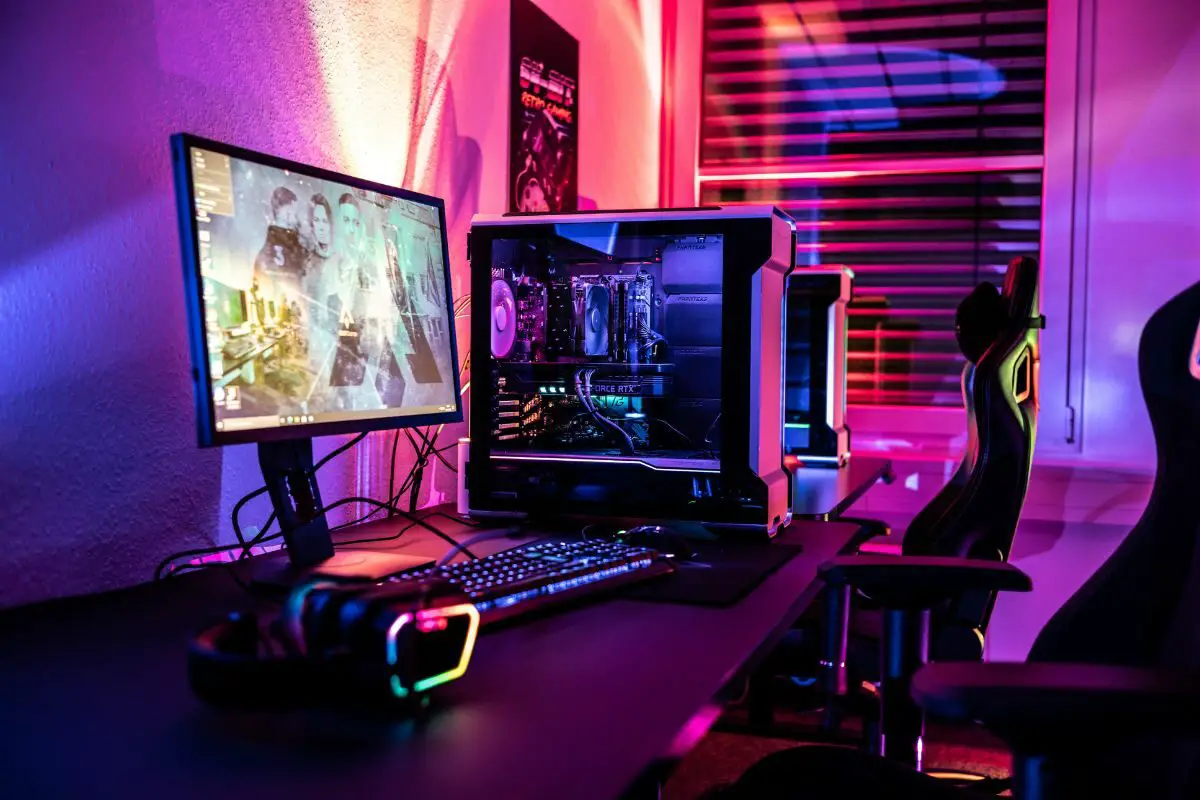
Monitoring CPU and GPU temp is much easier than you might think. All you need is a tool like MSI Afterburner or Core Temp and tweak a few settings to track the current temperature in real time.
I've been building gaming PCs for over two decades and have tried a dozen different monitoring software and hardware solutions to track my PC's temp while gaming.
I know the importance of tracking CPU and GPU temps during those intense gaming sessions. High CPU temperatures can cause all kinds of problems, from sluggish performance to permanent damage.
Using the methods discussed in this article, you'll be able to monitor all sorts of info related to your PC's performance within minutes.
So let's dive in!
Contents
The best way to monitor CPU temperature while gaming is by using a system monitoring utility such as MSI Afterburner or Core Temp app.
The best part? These tools are completely free of cost and work perfectly fine for both casual and hardcore gamers!
Here are some popular options you can try:

MSI Afterburner is a free application that lets you monitor your CPU temperature in real time. It also offers additional features like overclocking and fan control.
To use MSI Afterburner, simply download and install the software from the official MSI website. Once installed, launch the application and follow the steps described below:
You can toggle the On-Screen Display overlay using the ALT + O keys.
Besides CPU and GPU temperature, you can enable plenty of other sensors inside MSI Afterburner. Try using the "FPS," "clock speed," and "RAM usage" properties the next time you fire up your favorite game.
You can even adjust CPU/RAM clock speeds (overclocking), mess with fan speeds, and increase/decrease core voltage using the sliders on the main window.
If you don't need all the bells and whistles of MSI Afterburner and just want a more easy-to-use and compact alternative, try Core Temp.
The only drawback with this tool is that you don't get an on-screen tracker like MSI Afterburner. On the plus side, it's a very lightweight tool and will work well even on low-to-mid-end PCs.
Here's how to monitor CPU temp while gaming using Core Temp:
Besides the average temperature reading for each core, you'll also notice a parameter labeled as "Tj. Max." This is the maximum thermal junction temperature before your processor starts to throttle internally.
The Tj. Max is usually around 100ºC for most chips, and as long as you have a decent cooling setup, your CPU is unlikely to hit that temp while gaming.
As mentioned earlier, Core Temp doesn't offer an on-screen overlay, but you can see the live temperatures in the notification area (arrow button near the bottom right corner) in your taskbar. (Tip: You can pin these numbers to the taskbar to monitor them constantly.)

HWiNFO is free software that offers detailed information about your hardware components. It also offers tools for reporting and alerting systems, but we won't go into that today.
You can use it to monitor CPU and GPU temp as well as your motherboard, graphics cards, storage drives, memory, network, audio, and even connectivity ports.
If you want a thorough system summary and all the active sensor readings, HWiNFO will help you with that. However, it can be quite intimidating for newbies as there's too much info shown on a single page.
To use HWiNFO, firstly download and install the software from here. Then open it and switch to the Sensors tab. From there, you can view your CPU and GPU temp and other sensor information.
SpeedFan is another lightweight tool that offers much more than tracking CPU temps. As the name suggests, SpeedFan can be used to control your computer's fan speeds using pulse width modulation (PWM), provided your motherboard supports that.
Besides that, it can help you analyze drive temperatures (both HDD and SSD), CPU usage, clock speed, core temperatures, and voltages. You can download and install SpeedFan from here.
Both Intel and AMD offer their own utility tools to monitor CPU and GPU temp and tweak other system features - the Extreme Tuning Utility and Ryzen Master respectively.
However, they might not be available for all chipsets or Windows versions. Check the compatibility from the official website before installing these two applications.
These tools can also be used to overclock cores, memory, and graphics card. The only drawback is that you'll have to switch to the application from a game to monitor CPU and GPU temp, since there's no on-screen tracking.
Not many people are aware of all the functional aspects of their computer's BIOS (Basic Input Output System). It's an OG tool that offers plenty of basic troubleshooting measures, including your computer's CPU temperature readings.
To monitor CPU/GPU temperature inside BIOS, restart your computer and press the BIOS key (usually F2, F10, or Del key). From here, you need to navigate to the section labeled H/W Monitor or PC Health Status. Inside that, you'll find info regarding processor temperature, fan speeds, and voltages.
Granted, this is not a real-time monitoring solution, as you need to restart your PC to check CPU temperature. However, it can be incredibly helpful in case your PC freezes or shuts off due to overheating.
If you're a PC enthusiast and are comfortable with a more hands-on solution, you can try putting a temperature probe onto your motherboard.
These temperature sensors attach to your PC components directly and often come with an LCD display. The display will fit into any drive bay so you can see the CPU, GPU, and motherboard temperature at a glance.

If you notice that your processor is constantly overheating while gaming, there are a few things you can do to troubleshoot the issue:
Over time, dust can accumulate inside your PC case and clog up your cooling fans and heat sinks, leading to sizzling CPU temperatures.
If you suspect that dust buildup is the cause of your high CPU temperatures, turn off your computer and open up your PC case. Employ a can of compressed air or a soft brush to gently remove any dust from your cooling fans, heat sinks, and other components.
Do this every once in a while to maintain a steady airflow and keep the heat at bay. This will protect your PC from permanent damage.
Experienced gamers love to have complete control over all the fans on their PCs. I'm one of them!
Many PC cases come with built-in fan controllers that allow you to adjust the speed of your cooling fans. Alternatively, you can use software tools like MSI Afterburner and SpeedFan/FanControl to adjust your fan speed manually.
However, make sure to maintain a balance of cooling performance, noise, and power consumption. Running fans at speeds higher than necessary can also reduce their lifespan.
The thermal paste between your processor and heat sink helps to transfer heat away from your CPU. If the thermal paste is old or has been applied incorrectly, heat will accumulate near the chip resulting in high temperatures.
Turn off your computer and carefully remove your heat sink. Check that the thermal paste is evenly applied and not dried out or cracked. If it looks old and degraded, replace it asap.
If you've tried all the above solutions but nothing works, you likely need to upgrade your cooling system. This could include adding additional cooling fans (or replacing old fans with newer ones) or upgrading your heat sink. You could even install a liquid cooling system if your budget allows.
No! MSI Afterburner will work with any graphics card and mobo, not just MSI cards. Also note that most of the overclocking, monitoring, and cooling features can be used regardless of your GPU manufacturer.
However, in some cases and with specific graphics cards, certain tools like voltage control might not be available. But MSI Afterburner will still run perfectly fine on your computer.
Some of the tools mentioned above, including MSI Afterburner and HWiNFO, can be used to monitor GPU temp as well. But if you're looking for a tool specifically for your graphics card, NZXT CAM and GPU-Z are great options that work with almost all GPUs and brands.
Also, both AMD and Nvidia offer native tools for this purpose. For instance, you can use the Radeon Software if you have an AMD Radeon graphics card. For Nvidia cards, the Nvidia GeForce Experience and EVGA Precision X1 are superb tools that also offer in-game overlays.
Most home PCs operate at a safe range of 40–65°C under normal workloads (very thin ultrabooks might run a little warmer). Even under heavy loads and during gaming, the CPU and GPU temperatures should ideally stay below 80–85°C.
An FPS counter isn't a good indicator of hardware temperature. While reduced FPS can be caused due to overheating, it's not always the case. There are so many other factors affecting the in-game frame rate.
Different CPUs, GPUs, memory, etc., will result in different framerates even with similar working temperatures. Besides that, the code optimization, in-game graphics/resolution settings, and hardware compatibility all have an impact on the FPS.

So, there you have it!
It's super important to keep your CPU temperature in check if you want your rig to last and perform well. If your CPU gets too hot, it can cause all kinds of problems, from crashes to permanent damage.
Luckily, there are a bunch of things you can do to keep your CPU temperature at normal levels. By following the tips and tricks we've learned today, you can enjoy a smooth and stable gaming experience without worrying about your CPU overheating.
Happy gaming!
